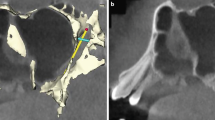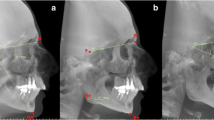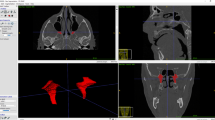Abstract
Purpose
The aim of this study was to investigate the detailed anatomy of the pterygomaxillary fissure (PMF) and pterygopalatine fossa (PPF) and variations therein using three-dimensional (3D) cone-beam computed tomography (CBCT) software.
Methods
This study was based on a retrospective evaluation of CBCT scans. A total of 825 CBCT images of patients (448 females, 377 males) who met the inclusion criteria were analyzed. PMF shapes were classified, and morphometric measurements (PMF area and PPF volume) were performed according to age, right/left side, and gender using 3D rendering programs. Maxillary and sphenoid sinus pathologies were also classified to reveal possible correlations between morphometric measurements. Analysis of variance was used for comparisons. Multiple comparisons were assessed using the Bonferroni test. Pearson’s test was used to assess correlations between parameters. A p value < 0.05 was considered to indicate statistical significance.
Results
Six types of PMF shapes were defined. There were no significant differences in types according to gender, age or sinus pathology. Males had a significantly larger PMF area than females (p < 0.001). Left/right comparison of the PMF area revealed that the mean PMF coronal, axial, and sagittal area dimensions were significantly higher on the right side in all patients. Our results also indicated that the PMF area and PPF volume increased significantly after 40 years of age.
Conclusion
Various PMF shapes were defined and classified. PMF and PPF dimensions increased with age. Knowledge of these anatomical variations will allow surgeons to avoid damage to the neurovascular structures passing through the area.




Similar content being viewed by others
References
Acar R, Şakul BU, Türkaslan A, Ercan MA (1991) Fissura pterygomaxillaris (Sphenomaxillaris)’in şekil varyasyonları ve bunun klinikteki önemi. Ankara Tıp Mecmuası 44:537–544
Arai Y, Tammisalo E, Iwai K, Hashimoto K, Shinoda K (1999) Development of a compact computed tomographic apparatus for dental use. Dentomaxillofac Radiol 28:245–248
Bannon R, Parihar S, Skarparis Y (2018) 3D printing the pterygopalatine fossa: a negative space model of a complex structure. Surg Radiol Anat 40:185–191
Bou Serhal C, Jacobs R, Gijbels F, Bosmans H, Hermans R, Quirynen M (2001) Absorbed doses from spiral CT and conventional spiral tomography: a phantom vs. cadaver study. Clin Oral Implant Res 12:473–478
Cruz AAV, dos Santos AC (2006) Blindness after Le Fort I osteotomy: a possible complication associated with pterygomaxillary separation. J Craniomaxillofac Surg 34(4):210–216. https://doi.org/10.1016/j.jcms.2006.01.001
Dargaud J, Cotton F, Buttin R, Morin A (2003) The maxillary sinus: evolution and function in aging. Morphologie 87(276):17–22
Derinkuyu BE, Boyunaga O, Oztunali C (2017) Pterygopalatine fossa: not a mystery! Can Assoc Radiol J 68:122–130
Dula K, Mini R, Lambrecht JT, Van der Stelt PF, Sehneeberger P, Sanderink GCH (1997) Hypothetical mortality risk associated with spiral tomography of the maxilla and mandible prior to endosseous implant treatment. Eur J Oral Sci 105:123–129
Dula K, Mini R, Van der Stelt PF, Sanderink GC, Schneeberger P, Buser D (2001) Comparative dose measurements by spiral tomography for preimplant diagnosis: the Scanora machine versus the Cranex Tome radiography unit. Oral Surg Oral Med Oral Pathol Oral Radiol Endod 91(6):735–742
European Commission, Radiation Protection NO, 172 SedentexCT (2012) Guidelines on CBCT for dental and maxillofacial radiology. Luxembourg, EU publication office. https://ec.europa.eu/energy/sites/ener/files/documents/172.pdf. Accessed 15 Dec 2018
Evans BT (2016) Infratemporal and pterygopalatine fossae and temporomandibular joint. In: Standring S (ed) Gray’s anatomy, 41st edn. Elsevier, Amsterdam, pp 534–555
Hitotsumatsu T, Matsushima T, Rhoton AL (1999) Surgical anatomy of the midface and the midline skull base. Oper Tech Neurosurg 2(4):160–180. https://doi.org/10.1016/S1092-440X(99)80017-6
Hwang K, Lee DK, Chung IH, Lee SI (2001) Le Fort I osteotomy with sparing fracture of lateral pterygoid plate. J Craniofac Surg 12:48–52
Justus J, Tuinzing DB, Greebe RB, van der Kwast WA (1991) Intra-and early postoperative complications of the Le Fort I osteotomy: a retrospective study on 410 cases. J Craniomaxillofac Surg 19(5):217–222. https://doi.org/10.1016/S1010-5182(05)80551-7
Kim HY, Kim MB, Dhong HJ, Jung YG, Min JY, Chung SK (2008) Changes of maxillary sinus volume and bony thickness of the paranasal sinuses in longstanding pediatric chronic rhinosinusitis. Int J Pediatr Otorhinolaryngol 72(1):103–108
Kim YH, Sato K, Mitani H, Shimizu Y, Kikuchi M (2003) Asymmetry of the sphenoid bone and its suitability as a reference for analyzing craniofacial asymmetry. Am J Orthod Dentofacial Orthop 124(6):656–662. https://doi.org/10.1016/S0889540603007716
Kumar V, Ludlow J, Soares Cevidanes LH, Mol A (2008) In vivo comparison of conventional and cone beam CT synthesized cephalograms. Angle Orthod 78(5):873–879
Lima SM Jr, de Moraes M, Asprino L (2011) Photoelastic analysis of stress distribution of surgically assisted rapid maxillary expansion with and without separation of the pterygomaxillary suture. J Oral Maxillofac Surg 69(6):1771–1775. https://doi.org/10.1016/j.joms.2010.07.035
Ludlow JB, Davies-Ludlow LE, Brooks SL (2003) Dosimetry of two extraoral direct digital imaging devices: NewTom cone beam CT and Orthophos Plus DS panoramic unit. Dentomaxillofac Radiol 32(4):229–234
Mah JK, Danforth RA, Bumann A, Hatcher D (2003) Radiation absorbed in maxillofacial imaging with a new dental computed tomography device. Oral Surg Oral Med Oral Pathol Oral Radiol Endod 96:508–513
Malamed SF, Trieger N (1983) Intraoral maxillary nerve block: an anatomical and clinical study. Anesth Prog 30(2):44–48
Moiseiwitsch J, Irvine T (2001) Clinical significance of the length of the pterygopalatine fissure in dental anesthesia. Oral Surg Oral Med Oral Pathol Oral Radiol Endod 92(3):325–328. https://doi.org/10.1067/moe.2001.115977
Moshiri M, Scarfe WC, Hilgers ML, Scheetz JP, Silveira AM, Farman AG (2007) Accuracy of linear measurements from imaging plate and lateral cephalometric images derived from cone-beam computed tomography. Am J Orthod Dentofac Orthop 132:550–560
Moss ML, Salentijn L (1969) The primary role of functional matrices in facial growth. Am J Orthod 55(6):566–577
Nish I, Pynn B, Holmes H, Young E (1995) Maxillary nerve block: a case report and review of the intraoral technique. J Can Dent Assoc 61(4):305–310
Puche-Torres M, Blasco-Serra A, Campos-Pelaez A (2017) Radiological anatomy of the fissura pterygomaxillaris for a surgical approach to ganglion pterygopalatinum. J Anat 231:961–969
Rhea JT, Novelline RA (2005) How to simplify the CT diagnosis of Le Fort fractures. AJR Am J Roentgenol 184(5):1700–1705. https://doi.org/10.2214/ajr.184.5.01841700
Scarfe WC, Farman AG, Sukovic P (2006) Clinical applications of cone-beam computed tomography in dental practice. J Can Dent Assoc 72(1):75–80
Silva MAG, Wolf U, Heinicke F, Bumann A, Visser H, Hirsh E (2008) Cone beam computed tomography for routine orthodontic treatment planning: a radiation dose evaluation. Am J Orthod Dentofac Orthop 133(5):640.e1–640.e5
Stajčić LS, Gačić B, Popović N, Stajčić Z (2010) Anatomical study of the pterygopalatine fossa pertinent to the maxillary nerve block at the foramen rotundum. Int J Oral Maxillofac Surg 39(5):493–496
Stechison MT, Brogan M (1994) Transfacial transpterygomaxillary access to foramen rotundum, sphenopalatine ganglion, and the maxillary nerve in the management of atypical facial pain. Skull Base Surg 4(1):15–20
Sukovic P (2003) Cone beam computed tomography in craniofacial imaging. Orthod Craniofac Res 6(Suppl 1):31–36
Tashi S, Purohit BS, Becker M, Mundada P (2016) The pterygopalatine fossa: imaging anatomy, communications, and pathology revisited. Insight Imaging 7:589–599
Thomas SL (2008) Application of cone-beam CT in the office setting. Dent Clin N Am 52(4):753–759
U.S.NRC (United States Nuclear Regulatory Commision) (2004) Biological effects on radiation. https://www.hsdl.org/?view&did=28420. Accessed 15 Dec 2018
van Vlijmen OJ, Bergé SJ, Swennen GR, Bronkhorst EM, Katsaros C, Kuijpers-Jagtman AM (2009) Comparison of cephalometric radiographs obtained from cone-beam computed tomography scans and conventional radiographs. J Oral Maxillofac Surg 67:92–97
William SC, Farman AG (2008) What is cone-beam CT and how does it work? Dent Clin N Am 52:707–730
Yonetsu K, Watanabe M, Nakamura T (2000) Age-related expansion and reduction in aeration of the sphenoid sinus: volume assessment by helical CT scanning. Am J Neuroradiol 21(1):179–182
Funding
There was no funding in this study.
Author information
Authors and Affiliations
Contributions
KO and MI: project development, data collection, and manuscript writing. MI: data collection and manuscript editing. MI and KO: data analysis.
Corresponding author
Ethics declarations
Conflict of interest
The authors declare that they have no conflict of interest.
Additional information
Publisher’s Note
Springer Nature remains neutral with regard to jurisdictional claims in published maps and institutional affiliations.
Rights and permissions
About this article
Cite this article
Icen, M., Orhan, K. Cone-beam computed tomography evaluation of the pterygomaxillary fissure and pterygopalatine fossa using 3D rendering programs. Surg Radiol Anat 41, 513–522 (2019). https://doi.org/10.1007/s00276-019-02201-2
Received:
Accepted:
Published:
Issue Date:
DOI: https://doi.org/10.1007/s00276-019-02201-2




